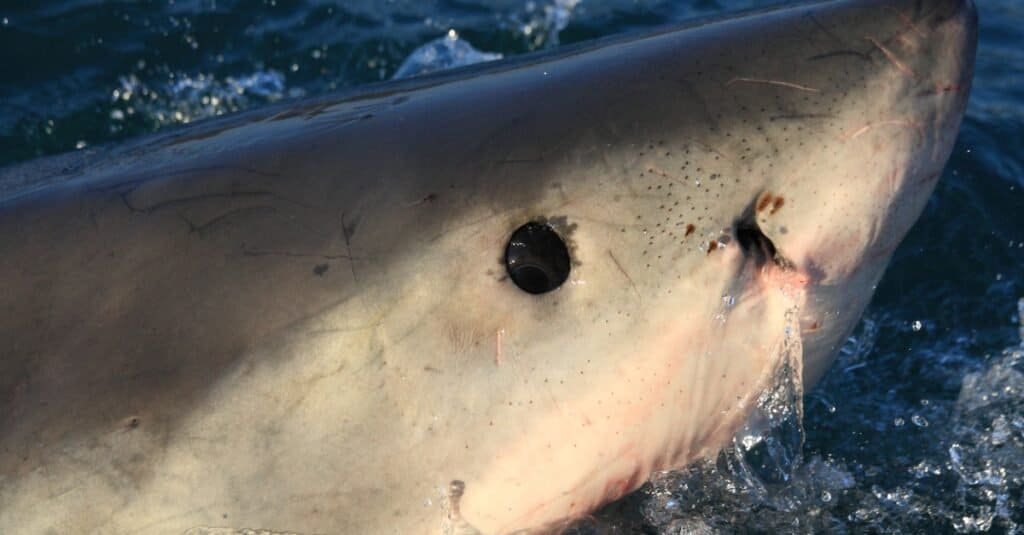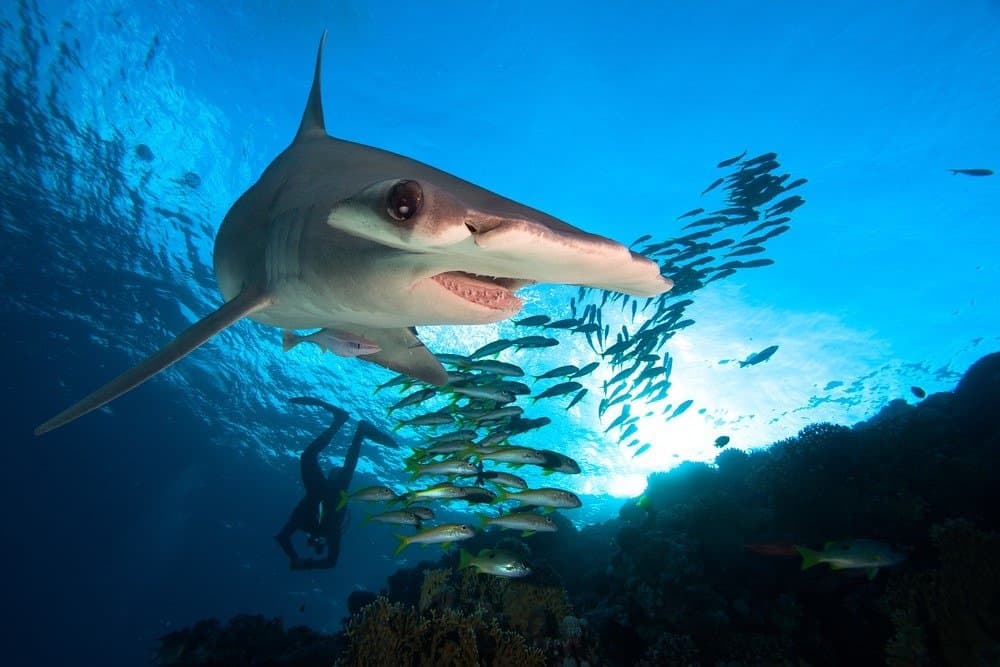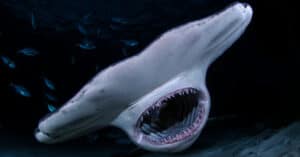Are Sharks Blind?
You’d agree that seeing a sea creature as massive as a shark can trigger one thousand emotions. But there is no crime to desire to learn more about them. The truth is several speculations have been made regarding sharks’ vision. And many people believe these gigantic sea creatures are blind, while others have a contrary opinion. Having considered our readers, we thought it wise to dissect a rare question often asked about these sea creatures. Please join us in this read as we find out more facts about these fascinating shark episodes.
Do Sharks Have Eyelids?

iStock.com/Alessandro De Maddalena
Of course, every shark has at least two precisely positioned eyelids that differ from humans’. Interestingly, some sharks have a nictitating membrane as their third eyelids, but their upper and lower eyelids are not as flexible as humans’. The nictitating membrane is a “highly dynamic structure” capable of providing “quick and efficient abrasion protection.” The eyelids of sharks are made of transparent membranes, and they serve as a protective shield over the eyes, even during a hunt. Despite their reliance on other sensory organs, these large aquatic animals still use their eyelids to shield their eyes in the case of danger.
Are Sharks Blind?

Martin Prochazkacz/Shutterstock.com
Sharks are not blind, and their vision is far better than we can imagine. While sharks have trouble distinguishing colors, their vision is still good enough to accomplish death-defying feats when hunting their prey. Intriguingly, their physical eye features resemble that of humans in terms of the cornea, lens, retina, deep blue iris, and pupil structures. In fact, like human eyes, sharks have two photoreceptors that control bright and low lights. The low-light vision is controlled by rods, while the cones control brighter light. These marine creatures also have two blind spots: one behind the snout and one behind the head.
The shark is one of the largest sea creatures, with eyes on both sides of its head, giving it far more peripheral vision. Like humans and other terrestrial predators like wolves, lions, and hawks, sharks have similar binocular vision that helps them see and hunt their prey in the quickest possible time.
What Attracts Sharks to Prey?
Finding out a list of things that attract sharks in the ocean can be quite daunting for an ordinary person; nevertheless, a concrete ideology has not been established over the years.
But one thing we know for certain is that the major feature that triggers these giant sea creatures to prey on smaller aquatic animals is ‘sound .’Fascinating as it seems, sharks tend to be attracted to certain irregular sounds, such as those created by a troubled swimmer or an injured fish, even when they are at a considerable distance. According to several scientific studies, another interesting feature that attracts sharks is ‘color .’Intriguingly, sharks can discriminate between light and dark colors, making aquatic prey more vulnerable to their attacks.
Are Sharks Colorblind?
In most terrestrial animals like humans, total color vision deficiency is uncommon. Color blindness is assumed to be ubiquitous in the marine environment, as whales and dolphins are color blind. Sharks’ ability to distinguish between different wavelengths of light has long been debated.
According to new research by Australian scientists, sharks are unable to differentiate colors, even though their close relatives, rays, and chimeras, have some color vision. Sharks’ eyes function throughout a wide range of light levels, but they only have one long-wavelength cone type in their retina. Nevertheless, most vertebrates’ eyes include specialized cells called photoreceptors that perceive light in the retina.
How Does A Shark Detect Motion?
When it comes to detecting motion and identifying possible prey, a shark’s vision is not the only thing it relies upon. It trusts its other senses, including smell, taste, hearing, and touch, while making a quick hunt. The sea monsters are thought to use their excellent sense of directional hearing to track down their prey. However, according to researchers, two specific sensors (lateral line system and acoustico- lateralis system) are used to detect motion. The lateral line system senses “low-frequency pressure fluctuations” provoked by a foreign body in the water. In contrast, the acoustico- lateralis system depends on the shark’s ear to sense motions in the water body.
What Colors Do Sharks See?
Sharks do not perceive color shades per se, but they can tell the difference between light and dark colors. Courtesy of their contrasting vision, sharks can more easily identify a person in a brightly yellow or orange colored swimming suit than one in a brown or gray swimming suit.
Can Sharks Smell?
Sharks have an interesting strong sense of smell with two small openings (nares) located just beneath their nasal cavities. Interestingly, each of these nares has two more apertures, allowing water to enter and exit freely. There are several delicate skin folds inside the nasal cavities with which water travels through to the sensory cells. These sensory cells help detect prey scents in the water while transmitting information to the shark’s brain, where the olfactory lobes kick in and analyze whether they are scents from a possible mate or prey. It is no surprise that sharks’ olfactory lobes make up about two-thirds of their brains, so this helps them make a quick judgment to pursue or let go of a possible sea prey.
Do Sharks Have Tongues?
Sharks and other smaller fish have a small, thick piece of cartilage on the floor of their mouths called the basihyal.
What Shark Has the Sharpest Vision?

frantisekhojdysz/Shutterstock.com
Every shark can see to a certain extent. Some sharks, surprisingly, have excellent visions, while others use a combination of senses to navigate their environment. Unlike many sharks with very poor vision, hammerhead sharks are believed to have exceptional sights. Their hammer-like heads with eyes on the sides of their flatheads help their vision fields converge behind them, giving them a full 360-degree view of their surroundings. Intriguingly, they are good with a 360-degree view, and they also have good use with their two-dimensional binocular vision (69 degrees).
More from A-Z Animals
You’d agree that seeing a sea creature as massive as a shark can trigger one thousand emotions. But there is no crime to desire to learn more about them. The truth is several speculations have been made regarding sharks’ vision. And many people believe these gigantic sea creatures are blind, while others have a contrary opinion. Having considered our readers, we thought it wise to dissect a rare question often asked about these sea creatures. Please join us in this read as we find out more facts about these fascinating shark episodes.
Do Sharks Have Eyelids?

iStock.com/Alessandro De Maddalena
Of course, every shark has at least two precisely positioned eyelids that differ from humans’. Interestingly, some sharks have a nictitating membrane as their third eyelids, but their upper and lower eyelids are not as flexible as humans’. The nictitating membrane is a “highly dynamic structure” capable of providing “quick and efficient abrasion protection.” The eyelids of sharks are made of transparent membranes, and they serve as a protective shield over the eyes, even during a hunt. Despite their reliance on other sensory organs, these large aquatic animals still use their eyelids to shield their eyes in the case of danger.
Are Sharks Blind?

Martin Prochazkacz/Shutterstock.com
Sharks are not blind, and their vision is far better than we can imagine. While sharks have trouble distinguishing colors, their vision is still good enough to accomplish death-defying feats when hunting their prey. Intriguingly, their physical eye features resemble that of humans in terms of the cornea, lens, retina, deep blue iris, and pupil structures. In fact, like human eyes, sharks have two photoreceptors that control bright and low lights. The low-light vision is controlled by rods, while the cones control brighter light. These marine creatures also have two blind spots: one behind the snout and one behind the head.
The shark is one of the largest sea creatures, with eyes on both sides of its head, giving it far more peripheral vision. Like humans and other terrestrial predators like wolves, lions, and hawks, sharks have similar binocular vision that helps them see and hunt their prey in the quickest possible time.
What Attracts Sharks to Prey?
Finding out a list of things that attract sharks in the ocean can be quite daunting for an ordinary person; nevertheless, a concrete ideology has not been established over the years.
But one thing we know for certain is that the major feature that triggers these giant sea creatures to prey on smaller aquatic animals is ‘sound .’Fascinating as it seems, sharks tend to be attracted to certain irregular sounds, such as those created by a troubled swimmer or an injured fish, even when they are at a considerable distance. According to several scientific studies, another interesting feature that attracts sharks is ‘color .’Intriguingly, sharks can discriminate between light and dark colors, making aquatic prey more vulnerable to their attacks.
Are Sharks Colorblind?
In most terrestrial animals like humans, total color vision deficiency is uncommon. Color blindness is assumed to be ubiquitous in the marine environment, as whales and dolphins are color blind. Sharks’ ability to distinguish between different wavelengths of light has long been debated.
According to new research by Australian scientists, sharks are unable to differentiate colors, even though their close relatives, rays, and chimeras, have some color vision. Sharks’ eyes function throughout a wide range of light levels, but they only have one long-wavelength cone type in their retina. Nevertheless, most vertebrates’ eyes include specialized cells called photoreceptors that perceive light in the retina.
How Does A Shark Detect Motion?
When it comes to detecting motion and identifying possible prey, a shark’s vision is not the only thing it relies upon. It trusts its other senses, including smell, taste, hearing, and touch, while making a quick hunt. The sea monsters are thought to use their excellent sense of directional hearing to track down their prey. However, according to researchers, two specific sensors (lateral line system and acoustico- lateralis system) are used to detect motion. The lateral line system senses “low-frequency pressure fluctuations” provoked by a foreign body in the water. In contrast, the acoustico- lateralis system depends on the shark’s ear to sense motions in the water body.
What Colors Do Sharks See?
Sharks do not perceive color shades per se, but they can tell the difference between light and dark colors. Courtesy of their contrasting vision, sharks can more easily identify a person in a brightly yellow or orange colored swimming suit than one in a brown or gray swimming suit.
Can Sharks Smell?
Sharks have an interesting strong sense of smell with two small openings (nares) located just beneath their nasal cavities. Interestingly, each of these nares has two more apertures, allowing water to enter and exit freely. There are several delicate skin folds inside the nasal cavities with which water travels through to the sensory cells. These sensory cells help detect prey scents in the water while transmitting information to the shark’s brain, where the olfactory lobes kick in and analyze whether they are scents from a possible mate or prey. It is no surprise that sharks’ olfactory lobes make up about two-thirds of their brains, so this helps them make a quick judgment to pursue or let go of a possible sea prey.
Do Sharks Have Tongues?
Sharks and other smaller fish have a small, thick piece of cartilage on the floor of their mouths called the basihyal.
What Shark Has the Sharpest Vision?

frantisekhojdysz/Shutterstock.com
Every shark can see to a certain extent. Some sharks, surprisingly, have excellent visions, while others use a combination of senses to navigate their environment. Unlike many sharks with very poor vision, hammerhead sharks are believed to have exceptional sights. Their hammer-like heads with eyes on the sides of their flatheads help their vision fields converge behind them, giving them a full 360-degree view of their surroundings. Intriguingly, they are good with a 360-degree view, and they also have good use with their two-dimensional binocular vision (69 degrees).






